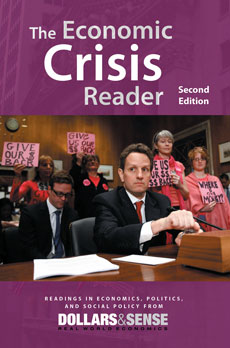The Economic Crisis Reader
Edited by Gerald Friedman, Fred Moseley, Chris Sturr, and the Dollars & Sense collective.

- Edition:
- 2nd
- Date of publication:
- November 2010
- ISBN:
- 978-1-878585-84-4
- Pages:
- 411
- Price:
- $34.95
- Introduction
- Introduction to the First Edition
- Chapter 1: General Explanations
- 1.1 The Greed Fallacy
- 1.2 Inequality, Power, and Ideology
- 1.3 Recession, Depression, Repression: What’s in a Name?
- 1.4 That ’70s Crisis
- 1.5 Crisis and Neoliberal Capitalism
- 1.6 Capitalism Hits the Fan
- 1.7 We’re All Minskyites Now
- 1.8 The “Credit Tsunami”
- 1.9 Profits, the Business Cycle, and the Current Crisis
- 1.10 Same Output + Fewer Hours = Economic Crisis?
- 1.11 Why Won’t the Economy Spring Back?
- Chapter 2: Warning signs
- 2.1 Bubble Trouble
- 2.2 A House of Cards
- 2.3 (Mis)Understanding a Banking Industry in Transition
- 2.4 America’s Growing Fringe Economy
- 2.5 Financialization: A Primer
- 2.6 Private Equity Exposed
- 2.7 Hedge Funds Arthur MacEwan
- 2.8 The Fed and America’s Distorted Expansion
- 2.9 Who Cares If Bear Stearns Fails?
- 2.10 Can the Fed Handle a Systemic Crisis? Maybe.
- Chapter 3: The Housing Bubble and Bust
- 3.1 The Homeownership Myth
- 3.2 What Were the Bankers Thinking?
- 3.3 Renters in the Crosshairs
- 3.4 How to Stop the Foreclosures
- 3.5 The Bailout of Fannie Mae and Freddie Mac
- 3.6 Who Gets Those Trillions?
- 3.7 Don’t Blame the CRA
- 3.8 Update on Mortgage Lending Discrimination
- Chapter 4: The Financial Meltdown
- 4.1 From Tulips to Mortgage-Backed Securities
- 4.2 Ponzi Schemes and Speculative Bubbles
- 4.3 Confidence Trick
- 4.4 Derivatives and Deregulation
- 4.5 Dealing with a Rotten Tooth
- 4.6 Time for Permanent Nationalization!
- 4.7 Trust Your Gut
- 4.8 Not Too Big Enough
- 4.9 Bonanzas as Usual
- 4.10 The Sad Future of Banking
- Chapter 5: Monetary Policy: The Fed and The Money Supply
- 5.1 Pushing on Strings
- 5.2 Bernanke’s Bad Teachers
- 5.3 The Bailouts Revisited
- 5.4 Of Bubbles and Bailouts
- 5.5 Fixing the Fed
- 5.6 Keynes and the Limits of Monetary Policy
- 5.7 Bad News, Good News, and Class Conflict
- 5.8 Pressure from the Bond Market
- Chapter 6: Fiscal Policy: Stimulus and Deficits
- 6.1 Stimulating Whining
- 6.2 How I Learned to Stop Worrying and Love the Deficit
- 6.3 Responding to Revisionism
- 6.4 Fiscal Policy and “Crowding Out”
- 6.5 Why Are Things Getting Worse and Worse?
- 6.6 The Economic Crisis in the States
- 6.7 State Budget Blues
- 6.8 Myths of the Deficit
- 6.9 The Deficit: Real Issue, Phony Debates
- Chapter 7: The Jobs Crisis
- 7.1 The Real Unemployment Rate Hits a 68-Year High
- 7.2 Unemployment: How Bad for How Long?
- 7.3 Unemployment Insurance: A Broken System
- 7.4 Employers Go on StrikeóBecause They Can
- 7.5 Gender and the Recession
- 7.6 A Dismal Time to Graduate
- 7.7 How Blacks Might Fare in the Jobless Recovery
- Chapter 8: Industrial and Employment Policy
- 8.1 Bail Out the Safety Net
- 8.2 Creating Decent Jobs
- 8.3 Is Military Keynesianism the Solution?
- 8.4 We Need a (Green) Jobs Program
- 8.5 Saving Energy Creates Jobs
- 8.6 Eighteen Million Jobs by 2010
- 8.7 A New WPA?
- 8.8 Changing the Auto Industry from the Wheels Up
- Chapter 9: Labor Activism
- 9.1 The Global Crisis and the World Labor Movement
- 9.2 The Real Audacity of Hope
- 9.3 Corporate America’s Counter-Stimulus Strategy
- 9.4 Worker Direct Action Grows in Wake of Financial Meltdown
- 9.5 Greece as a Demonstration Project
- 9.6 Should We Be Talking About Living Wages Now?
- 9.7 On Strike in China
- Chapter 10: The International Crisis
- 10.1 The Giant Pool of Money
- 10.2 W(h)ither the Dollar?
- 10.3 Putting the “Global” in the Global Economic Crisis
- 10.4 (Economic) Freedom’s Just Another Word for...Crisis-Prone
- 10.5 Tax Havens and the Financial Crisis
- 10.6 Beyond the World Creditors’ Cartel
- 10.7 No Bailout for AIDS
- 10.8 The Beijing Statement
- 10.9 The Caracas Statement
- Contributors
